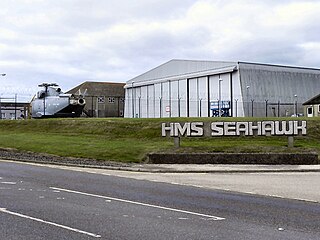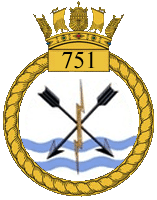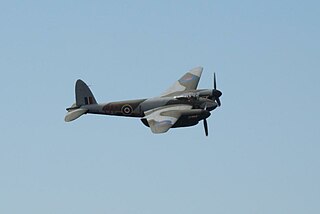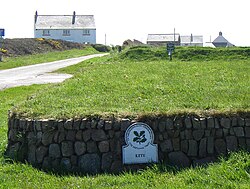
Royal Air Force Brawdy, or more simply RAF Brawdy, is a former Royal Air Force satellite station located 6.3 miles (10.1 km) east of St Davids, Pembrokeshire and 9.8 miles (15.8 km) south west of Fishguard, Pembrokeshire, Wales. It was operational between 1944 and 1992; it was used by the Royal Air Force and the Royal Navy (1946–1971), before the site was turned over to the British Army and renamed Cawdor Barracks.

Royal Naval Air Station Culdrose is a Royal Navy airbase near Helston on the Lizard Peninsula of Cornwall UK, and is one of the largest helicopter bases in Europe. Its main role is serving the Fleet Air Arm's front line AgustaWestland Merlin helicopter squadrons.

The Fleet Requirements and Air Direction Unit (FRADU) was a unit of the Royal Navy's Fleet Air Arm operated by the contractor Serco Defence and Aerospace. It was established in 1972. It was most recently equipped with 13 BAE Systems Hawk T1 advanced jet trainer aircraft on lease to the Royal Navy from the Royal Air Force, based at RNAS Culdrose in Cornwall. Two of these aircraft were permanently detached to Naval Flying Standards Flight at RNAS Yeovilton where they are flown by RN pilots, but maintained by Serco engineers.

Royal Naval Air Station Dale is a former Royal Naval Air Station, located 10 miles (16 km) South West of Haverfordwest in Pembrokeshire, Wales. It was operational between 1942 and 1948, being used by both the Royal Air Force (1942–1943) and the Royal Navy (1943–1948).

792 Naval Air Squadron was a Naval Air Squadron of the Royal Navy's Fleet Air Arm and was originally formed at RNAS St Merryn in August 1940 as an Air Target Unit, equipped with six Blackburn Skuas. The squadron disbanded in 1945 and merged with 794 Naval Air Squadron. 792 Squadron reformed at RNAS Culdrose in 1948 as a Night Fighter Training Unit. It was initially equipped with Fairey Firefly NF.1s and Avro Ansons. They were later replaced with Sea Hornets shortly before the squadron disbanded again in August 1950.

Royal Air Force St Davids, or more simply RAF St Davids, is a former Royal Air Force station, near the city of St Davids, Pembrokeshire, Wales, in the community of Solva.

707 Naval Air Squadron was a Naval Air Squadron of the Royal Navy's Fleet Air Arm which disbanded during February 1995. It was active during the Second World War forming during February 1945 as a Radar Trials Unit, disbanding in October of the same year. It reformed December 1964, as an Advanced and Operational Flying Training Commando helicopter squadron.

748 Naval Air Squadron was a Naval Air Squadron of the Royal Navy's Fleet Air Arm. It was initially formed, at RNAS St Merryn, as a Fighter Pool Squadron, before becoming No. 10 Naval Operational Training Unit. The squadron moved to RNAS Henstridge in February 1944 and then onto RNAS Yeovilton in the March. In September 1944, 748 NAS moved to RNAS Dale, in Wales, remaining for just under twelve months, before moving back to RNAS St Merryn in August 1945, where it disbanded in February 1946. During its existence, the squadron was equipped with numerous aircraft and various marks, operated by the Fleet Air Arm.

751 Naval Air Squadron was a Naval Air Squadron of the Royal Navy's Fleet Air Arm. It was initially active as an Observer Training Squadron from 1939 to 1944 as part of No.1 Observer School. 751 Naval Air Squadron formed at RNAS Ford in May 1939. Ford was attacked and bombed, in August 1940, and the following day the squadron relocated to RNAS Arbroath. Twelve months later it moved to RNAS Dundee, remaining there until disbanding at Dundee in May 1944.

759 Naval Air Squadron was a Naval Air Squadron of the Royal Navy's Fleet Air Arm. It was created on November 1, 1939, and was disbanded on December 24, 1969. It was initially intended as a Telegraphist Air Gunner Training Squadron but became a Fighter School and Pool Squadron in 1939, at RNAS Eastleigh. It operated out of RNAS Yeovilton from 1940 to 1946, as part of the Naval Air Fighter School. In 1943 a detachment operated out of RNAS Angle, working with 794 NAS and known as the Naval Air Firing Unit. It was again the Naval Air Fighter School upon reformation in 1951 and disbandment in 1954, firstly at RNAS Culdrose and then moving to RNAS Lossiemouth, in 1953. The squadron reformed again, this time at RNAS Brawdy in 1963, as the Naval Advanced Flying Training School, before finally disbanding in 1969.

760 Naval Air Squadron is a Naval Air Squadron of the Royal Navy's Fleet Air Arm. The squadron first formed in April 1940 as No.1 Fleet Fighter Pool with a variety of aircraft types before standardising in 1941 on the Hawker Sea Hurricane. In this role it disbanded in December 1942. In May 1944 760 NAS briefly reformed as an Anti-Submarine Operational Training Squadron before disbanding into 766 Naval Air Squadron in November. Reformed again as part of No.1 Naval Air Fighter School in April 1945 it converted fighter pilots to the Vought Corsair and then the Supermarine Seafire until 23 January 1946 when it disbanded.

762 Naval Air Squadron was a Naval Air Squadron of the Royal Navy's Fleet Air Arm. It formed at HMS Heron, RNAS Yeovilton, in March 1942 as an Advanced Flying Training School. Almost immediately the squadron relocated to HMS Vulture, RNAS St Merryn, but before the end of the year, it was back at HMS Heron. The squadron disbanded nine months later.

765 Naval Air Squadron was a Naval Air Squadron of the Royal Navy's Fleet Air Arm. It formed at RNAS Lee-on-Solent, in May 1939, as a Seaplane School and Pool squadron. The squadron moved to RNAS Sandbanks, in August 1940, where it undertook the Seaplane Flying Training Course Part I. Lieutenant Commander Wilson was appointed as dual officer in charge of the air base, and Commanding officer of 765 NAS. By the middle of 1943, dedicated Seaplane Training schools ended and the squadron disbanded in the October. 765 NAS reformed at RNAS Charlton Horethorne, in early February 1944, as a Travelling Recording Unit. The squadron moved to RNAS Lee-on-Solent in March, before moving to RNAS Worthy Down on one month later during April, then in May it moved to RNAS Stretton, were it remained during June.

766 Naval Air Squadron was a Naval Air Squadron of the Royal Navy's Fleet Air Arm. It was to have initially formed in 1939 at RNAS Lee-on-Solent, as a Seaplane School, however, it formed at RNAS Machrihannish as a Night ALT Course, in 1942. It moved to RNAS Inskip, in 1943, to become part of No. 1 Naval Operational Training Unit. By 1944, it was operating over 30 swordfish aircraft, but, during the year, also acquired Firefly aircraft from 1772 NAS, and Sea Hurricane aircraft from 760 NAS. It moved to RNAS Rattray early in 1946, but later that year, moved to RNAS Lossiemouth where it received Seafire aircraft, along with being Part 1 of the Operational Flying School. By late 1951, Sea Fury trainer aircraft were also added to its varied list of types operated. In 1953, the squadron moved to RNAS Culdrose, where it disbanded in 1954.

767 Naval Air Squadron was a Naval Air Squadron of the Royal Navy's Fleet Air Arm. It was initially formed as a Deck Landing Squadron in 1939, when 811 Naval Air Squadron was renumbered 767 NAS, at RNAS Donibristle. A detachment went to Hyeres de la Palyvestre in the south of France, enabling training in fairer conditions. While here, the squadron took on an operational mission, with a bombing attack on the Italian port of Genoa. With the fall of France the squadron evacuated to Algeria, where it split. Part went to Malta, forming 830 Naval Air Squadron, the other part to HMS Ark Royal, with personnel returning to the UK via Gibraltar. The squadron regrouped at RNAS Arbroath and moved to the Deck Landing School at RNAS East Haven in 1943.

780 Naval Air Squadron was a Naval Air Squadron of the Royal Navy's Fleet Air Arm which last disbanded at HMS Seahawk, RNAS Culdrose in November 1949. 780 Naval Air Squadron formed at HMS Raven, RNAS Eastleigh as a Conversion Course Unit, in October 1939, to train experienced civilian pilots in naval flying. It moved to HMS Daedalus, RNAS Lee-on-Solent, in October 1940, and later, its role had changed to converting pilots to Fairey Barracuda aircraft. It spent a year at RNAS Charlton Horethorne, before returning to HMS Daedalus and disbanded, early 1945. In March 1946, the squadron reformed at HMS Godwit, RNAS Hinstock, as the Naval Advanced Flying School, to give flying instructors' courses, and later provided Instrument Flying Training. In December, the squadron moved to HMS Jackdaw, RNAS Crail, then in March 1947 moved to HMS Merlin, RNAS Donibristle, and in May to HMS Seahawk as the first resident unit.

784 Naval Air Squadron was a Naval Air Squadron of the Royal Navy's Fleet Air Arm which last disbanded in the autumn of 1946. 784 NAS was a Night Fighter Training Squadron which formed at HMS Daedalus, RNAS Lee-on-Solent, Hampshire, in June 1942, moving to HMS Nighthawk, RNAS Drem, East Lothian, in October 1942. Squadron Personnel were also detached to the Naval Air Radio Installation Unit at RAF Christchurch, in 1943 and in the same year, a number of crews were attached to RAF night fighter squadrons, with two officers gained Distinguished Flying Crosses. In 1944, three squadron Flights were attached for service to each of 813, 825 and 835 Naval Air Squadrons, embarked in the escort carriers HMS Campania, HMS Vindex, and HMS Nairana respectively, on convoy protection duties. At the beginning of 1946 the squadron moved to Wales, operating out of HMS Goldcrest II, RNAS Brawdy.

790 Naval Air Squadron was a Naval Air Squadron of the Royal Navy's Fleet Air Arm which disbanded in November 1949 at RNAS Culdrose. It initially formed during 1941 as an Air Target Towing Unit, at HMS Landrail, RNAS Macrihanish, in Scotland, from elements of two other Fleet Air Arm squadrons, however, this only lasted for three months and the unit was disbanded, absorbed into 772 Naval Air Squadron. It reformed the following year, in July 1942, tasked as a Fighter Direction Training Unit, at RNAS Charlton Horethorne. It provided support for the Fighter Direction School and had short spells at RAF Culmhead and RNAS Zeals, before reloacting to RNAS Dale in Pembrokeshire, next to the new purpose built Air Direction School, HMS Harrier or RNADC Kete, in 1945. The squadron moved to HMS Seahawk in Cornwall during December 1947.

794 Naval Air Squadron was a Naval Air Squadron of the Royal Navy's Fleet Air Arm which disbanded in March 1947. The squadron formed as an Air Target Towing Squadron, at HMS Heron, RNAS Yeovilton, during August 1940, although operated target tug aircraft out of the satellite, RNAS Haldon. In April 1943 it provided a detachment at RAF Warmwell as an air firing unit and three months later the squadron relocated to RNAS Angle and became the Naval Air Firing Unit. Further moves followed in quick succession, to HMS Goldcrest, RNAS Dale, in September, HMS Dipper, RNAS Henstridge, in November and HMS Heron II, RNAS Charlton Horethorne in December and by which time the squadron was designated No. 1 Naval Air Firing Unit, but disbanded in June 1944. The squadron reformed at HMS Vulture, RNAS St Merryn, in January 1945, as the School of Air Firing and later in the year was tasked to support the newly-formed Ground Attack School. It moved to HMS Gannet, RNAS Eglinton, during August, and at this point had three flights providing courses for aerial warfare, airstrike and aerial reconnaissance.

796 Naval Air Squadron was a Naval Air Squadron of the Royal Navy's Fleet Air Arm which last disbanded at RNAS Culdrose in October 1958. 796 Naval Air Squadron formed as the Eastern Fleet Torpedo Bomber Reconnaissance Pool, at RN Air Section Port Reitz, in Mombasa, in July 1942, it provided a detachment embarked in HMS Illustrious in August to support the invasion of Madagascar. This Flight also disembarked to Majunga in September to join 207 Group of the Royal Air Force and later rejoined the squadron at RNAS Tanga, in November and added operational training unit to its roles until disbanding in April 1944. It reformed in November 1947 at HMS Vulture, RNAS St Merryn, as the Aircrewman Training School, for conversion of T.A.G.'s to aircrewman standard. Its task changed to Observer School Part II in January 1950. The squadron moved to HMS Seahawk, RNAS Culdrose, in November 1953 and in 1957 took on the task of the disbanded 765 Naval Air Squadron.























